
About UsThe Numismatic Bibliomania Society is a non-profit organization devoted to the study and enjoyment of numismatic literature. For more information please see our web site at coinbooks.org SubscriptionsThose wishing to become new E-Sylum subscribers (or wishing to Unsubscribe) can go to the following web page link MembershipThere is a membership application available on the web site Membership Application To join, print the application and return it with your check to the address printed on the application. Membership is only $20 to addresses in the U.S., $25 for First Class mail, and $30 elsewhere. For those without web access, write to: David M. Sundman, Treasurer AsylumFor Asylum mailing address changes and other membership questions, contact David at this email address: dsundman@LittletonCoin.com SubmissionsTo submit items for publication in The E-Sylum, just Reply to this message, or write to the Editor at this address: whomren@gmail.com
BUY THE BOOK BEFORE THE COIN |
- WAYNE'S WORDS: THE E-SYLUM FEBRUARY 15, 2015
- KOLBE & FANNING HOLDING FEB. 28 ONLINE SALE
- NEW BOOK: MEDALLIC ART OF THE ANS, 1865-2014
- NEW BOOK: KUSHAN, KUSHANO-SASANIAN, AND KIDARITE COINS
- BANK OF CANADA SOUVENIR BOOKS
- BOOK REVIEW: COINAGE IN THE ROMAN ECONOMY
- GEORGE CUHAJ JOINS ARCHIVES INTERNATIONAL AUCTIONS
- JEREMY CHEEK RETIRES FROM MORTON & EDEN
- BRUCE BARTELT ON THE MONEY MAKER, BOTTLE TOKENS, ST. ELIGIUS
- NOTES FROM E-SYLUM READERS: FEBRUARY 15, 2015
- HOMESTEAD NATIONAL MONUMENT QUARTER LAUNCH
- WAYNE'S NUMISMATIC DIARY: FEBRUARY 15, 2015
- ANS PARTNERS WITH HATHITRUST
- THE PARIS MINT'S WAVY COIN DESIGN
- ON THE TYPES OF COIN EDGES
- THE ARAGON BALLROOM ENCASED FRANKLIN HALF
- FERROTYPES FROM LINCOLN'S SECOND CAMPAIGN SOUGHT
- SOME INTERESTING MEDALS: FEBRUARY 15, 2015
- THE O K VENDER GAMBLING MACHINE TOKEN
- BANK OF AMERICA $5000 COLOR FACE PROOF
- OFFICIALS ACCUSE ARTIST OF PRINTING COUNTERFEIT MONEY
- LARGE HOARD OF ANGLO SAXON COINS DISCOVERED
- HUNGARIAN MINT STRIKES WOODEN MEDAL
- EROTICISM ON ANCIENT COINS
- DENVER MINT WATER MAIN BURST
Click here to access the complete archive
To comment or submit articles, reply to whomren@gmail.com
WAYNE'S WORDS: THE E-SYLUM FEBRUARY 15, 2015

New subscribers this week include: Nicholas Weiss and Daniel Salzer. Welcome aboard! We now have 1,820 subscribers.
This week we open with a reminder from literature dealers Kolbe & Fanning, two new books, and articles on some older ones. Other topics include auction house personnel changes, bottle return tokens, wavy coins, coin edges, ferrotype Lincoln campaign items, a large hoard of Anglo-Saxon coins.
To learn more about St. Eligius, the Dr. Edward Maris sale (H.P. Smith, 1886), medallic art of the American Numismatic Society, Coinage in the Roman Economy and the Queen’s numismatist, read on. Have a great week, everyone!
Wayne Homren
Editor, The E-Sylum
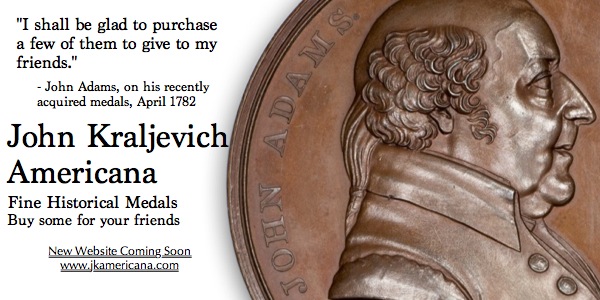
KOLBE & FANNING HOLDING FEB. 28 ONLINE SALE
Kolbe & Fanning Numismatic Booksellers have announced that their February 28 online sale has been posted, and that bidders may browse the sale’s contents through the firm’s online bidding portal at auction.numislit.com.
This is the first in what is expected to be a series of smaller online numismatic book auctions held by Kolbe & Fanning in addition to their traditional printed and public auctions. The Feb. 28 sale focuses on North American numismatic literature, and features 380 lots ranging in estimated value from $20 to $2000. All lots are illustrated and feature the full descriptions collectors have come to expect from Kolbe & Fanning.
Some sale highlights include:
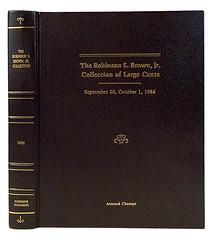 Deluxe leather-bound presentation editions, limited to ten copies each, of both the 1986 Robinson Brown and 1989 Jack Robinson large cent sales conducted by Superior (lots 337 and 339, respectively).
Deluxe leather-bound presentation editions, limited to ten copies each, of both the 1986 Robinson Brown and 1989 Jack Robinson large cent sales conducted by Superior (lots 337 and 339, respectively).
Sale catalogues of W. Elliot Woodward, including plated copies of his 1885 J. Colvin Randall sale (lot 374) and his masterly All the Kingdoms of the World sale of 1884 (lot 372).
A substantial group of catalogues of the New Netherlands Coin Company, including many early sales (lot 255).
George Clapp’s visually impressive work on the cents of 1798 and 1799 (lot 112).
 Original plated catalogues of the 1909 Henry Jewett sale (S.H. Chapman, lot 98), the 1913 Sargent sale (S.H. Chapman, lot 102) and the 1913 Malcolm Jackson sale (United States Coin Company, lot 349).
Original plated catalogues of the 1909 Henry Jewett sale (S.H. Chapman, lot 98), the 1913 Sargent sale (S.H. Chapman, lot 102) and the 1913 Malcolm Jackson sale (United States Coin Company, lot 349).
A copy of the scarce catalogue of the Dr. Edward Maris sale (H.P. Smith, 1886), with two of the photographic plates (of six called for), both featuring New Jersey coppers and both annotated by F.C.C. Boyd (lot 292).
The online sale is available now for browsing and absentee bidding at
auction.numislit.com. A PDF of the catalogue can be downloaded for the convenience of the reader through the firm’s regular website at
Customers who have participated online in any of Kolbe & Fanning’s recent sales will be familiar with the process. Others are encouraged to set up an iCollector account through auction.numislit.com and see for themselves how easy it is. Bidders wishing to participate in the live sale are strongly encouraged to register in advance.
Any questions may be directed to David Fanning at
df@numislit.com or by phone at (614) 414-0855. We look forward to your participation.
During the past 150 years, the American Numismatic Society has been a leader in the publication of art medals in the United States. Generally employing the finest medalists available, the Society has set an example few can match. In addition, with the exception of the United States Mint, no U.S. entity can boast so long and distinguished a contribution in this area. Founded in 1858, the American Numismatic and Archaeological Society, as it was known from 1864-1907, believed the issuance of medals to be a part of its mission from the earliest years of its existence.
Author Scott H. Miller includes 60 medals issued by the ANS between 1865 and 2014 along with two COAC medals and the 1910 Actors’ Fund Medal, all accompanied by color photographs. Many entries are supplemented by artist’s sketches and archival photographs as well as the stories behind each issue. Four Appendixes include recipients of some of these medals as well as the list of dies, hubs, galvanos, and casts of ANS medals in the ANS’s own collection.
Expected ship date: Spring 2015
For more information, or to purchase, see:
The Kushan Empire was a vast inland empire that stretched across Central and South Asia during the first to fourth centuries AD. The origins of Kushan dynasty continue to be debated, and precise dates, especially for the late Kushan kings, remain elusive, but the coinage reveals the Kushan dynasty as a major force in the cultural and political history of the ancient Silk Road.
Kushan coinage began c. AD 50 with issues of the first Kushan king, Kujula Kadphises(c. AD 50-90). The first Kushan coins were based on Greek, Scythian and Parthian coin designs already current in the territory of present day Afghanistan and Pakistan. Under Kujula Kadphises’ son Wima Takto (c. AD 91-113) and grandson Wima Kadphises (c. AD 113-127) the coinage system was gradually centralized to serve the entire Kushan empire, stretching from Uzbekistan and Tajikistan to northern India. Gold and copper denominations were established during the reign of Wima Kadphises which were maintained through the reigns of ten more kings until the demise of the Kushan empire in the mid-fourth century AD.
This catalogue presents all the Kushan coins in the American Numismatic Society, with selected illustrations, detailed descriptions and commentary. The production system of Kushan coinage is presented with major revisions of chronology and organization compared with previous publications. This presentation has been based on the latest coin-based research, including die studies and site find analysis. The coins are classified by ruler, metal, mint, production phase, denomination, type and variety. Introductory essays present the historical and cultural contexts of the kings and their coins. All the ANS gold coins and a selection of copper coins are illustrated. This catalogue also features two series of coins issued by the Kushano-Sasanian and the Kidarite Hun rulers of former Kushan territory because they followed and adapted the Kushan coinage system.
The authors intend this catalogue to be a tool for scholars and collectors alike for understanding, identifying, and attributing these fascinating coins that represent four centuries of Central and South Asian ancient history.
Expected ship date: Spring 2015
For more information, or to purchase, see:
The Bank of Canada has a group of six souvenir books that they have published in addition to their many technical (economics and business) publications. One of these souvenir books, “A History of the Canadian Dollar” by James Powell was reviewed in these pages in the September 23, 2012 issue of The E-Sylum. The other series of five are also worth a look.
“The Bank of Canada: An Illustrated History” features interesting images and anecdotes about Canada's central bank and its place in Canadian society from 1935 until the present.
Published to commemorate the Bank's 70th anniversary, this souvenir book depicts the history of the Bank through descriptive text, photographs, and reproductions of cartoons, newspaper clippings, posters, and other artifacts. Soft cover, 116 pages (2005).
“The Art and Design of Canadian Banknotes” offers readers a behind-the-scenes look at the demanding world of bank note design, highlighting the beauty of Canada's bank notes and celebrating the engraver's art. Soft cover, 124 pages (2006).
“More than Money: Architecture and Art at the Bank of Canada” takes you on a tour of the head office complex, highlighting interesting features of architecture, interior design, and decoration, as well as elements of restoration and preservation. It also features pieces from the Bank's art collection. Soft cover, 128 pages (2007). It is now a bit dated since a major renovation got underway in 2013.
“Beads to Bytes: Canada’s National Currency Collection” explores money and the role it has played, and continues to play, in society, through the lens of Canada's National Currency Collection. The Collection is an extraordinary repository of coins, bank notes, and related paraphernalia from around the world. Soft cover, 124 pages (2008). It generally covers the history of numismatic study in Canada, making it one of the most interesting books in this series.
While it is bad news to bibliophiles that all of these books are no longer offered in print, they are available for download in PDF format. I have placed them on my iPad and they make for highly enjoyable reading with no loss of quality.
For download, visit
http://www.bankofcanada.ca/publications/books-and-monographs/bank-canada-souvenir-books/ for English and
http://www.banqueducanada.ca/publication/livres-et-monographies/serie-livres-souvenirs-banque-canada/ for French.
To read the earlier E-Sylum article, see:
I’m always a little embarrassed when CoinWeek describes me as an “ancient coin expert.”
I know some of the real experts–people who’ve built up an encyclopedic database of numismatics over a lifetime, neatly organized and cross-indexed for instant access in their brains. I am awed by their abilities, but my brain doesn’t work that way.
Fortunately, it doesn’t have to. I may not have all the information in my head, but I know where to find it. I have the books right here.
Normal people (those who are not coin geeks) often ask, “Why do you need so many damn books?”
It’s a fair question.
In Classical numismatics, as in so many other fields, we often find ourselves drowning in information but starved for context. Collectors experience a flood of ancient coins, beautifully imaged and meticulously described on dealer web sites or arriving in the mailbox with each season’s surge of new auction catalogs. But it’s not always easy to find resources that help us understand what these coins meant, and how they worked.
Coinage in the Roman Economy by Kenneth Harl provides that context.
Harl’s book is a scholarly work intended for academic readers. It assumes a basic familiarity with ancient history, but it’s also an accessible source for the kind of information that collectors of Roman and related coins need to know, to understand exactly what it is that we collect with such passion.
Packing a thousand years of economic history into a little more than 300 pages of text is a masterful accomplishment. While it’s not light reading, especially for beginners, the prose is lucid. Clear black and white plates illustrate 267 coins mentioned in the text. There is a glossary of English and Latin terms, and an Appendix explaining Roman weights and measures. A well-organized “Select Bibliography” fills 46 pages, providing a reliable guide to the current and classic literature of Ancient Roman numismatics in English, French, Italian and German.
The only feature I missed was a list of tables, since the tables scattered throughout the text provide a wealth of useful information. For example:
Coinage in the Roman Economy is a book every serious collector of Roman coins should consider. It belongs in your high-traffic reference library, on the shelf with David Sear’s Roman Coins and Their Values and David Vagi’s monumental two-volume Coinage and History of the Roman Empire (which I hope to review in a future “First Read”).
Kenneth Harl (B.A. Trinity College, M.A, Ph.D Yale) is a professor of history and Fellow of the American Numismatic Society. He has taught Classical and Byzantine history at Tulane University since 1978. He is also the author of two compact, inexpensive handbooks for archaeologists on Roman and Byzantine coins commonly found at dig sites in Turkey.
To read the complete article, see:
For more information, or to purchase, see:
Dr. Robert Schwartz, President of Archives International Auctions is pleased to announce that Mr. George Cuhaj will be joining Archives International Auctions LLC as Vice-President of Cataloging and Consignor relations.
He is past president of the American Medallic Sculpture Association; An allied professional member of the National Sculpture Society; and, a Fellow of both the American Numismatic Society and the Royal Numismatic Society. He also holds life memberships in the ANA, CSNS and TAMS.
He has had articles published in The Numismatist; The Medal (publication of the British Art Medal Society), and several regional publications. His art medals have been exhibited at the international exhibitions sponsored by FIDEM.
Archives International Auctions is located in Ft. Lee NJ. Their current auction information and catalog can be located on the website at
WWW.ARCHIVESINTERNATIONAL.COM. They can be reached at 1-201-944-4800 or by email at
info@archivesinternational.com.
However, despite having reached his 65th birthday last year, Jeremy will still be seen on the auction circuit, making himself available to collectors for consultation, valuations, viewing and bidding at auctions on their behalf and providing expert cataloguing for auctioneers when required.
“Experience counts for a lot. It is a precious asset that people value highly and coin people never stop, so I suppose I should call this a semi-retirement,” Jeremy said.
Jeremy joined the staff of Morton & Eden in 2008 at a time when they were associated with Sotheby’s. His numismatic career started with the well known firm of B. A. Seaby Ltd and subsequently spent 12 years with coin dealers and auctioneers Spink & Son Ltd who also advised Christie’s on coin valuations for many years. Spink held auctions in Christie’s London galleries and jointly with Christie’s overseas.
He will continue in his position as Honorary Numismatic Advisor to the Royal Collection, which he helps curate at Windsor Castle and is currently writing a catalogue of the coins and medals in the Royal Collection.
Jeremy can be contacted by telephone on 0777 3872686; via his website, www.jcheekcoins.com or by email at Jeremycoin@aol.com.
Money Maker Secret
To read the earlier E-Sylum article, see:
Bottle-Redeeming Tokens
The discussion on food stamp tokens and the plastic versions illustrated reminded me of a couple grocery-related tokens in my collection. A local Milwaukee food chain used similar tokens when redeeming the deposit on returned bottles. I obtained these in 1981 and 1983. Another obscure path in paranumismatica.
To read the earlier E-Sylum articles, see:
FOOD STAMP CHANGE TOKEN INFORMATION SOUGHT
(www.coinbooks.org/esylum_v18n04a06.html)
THE HISTORY OF FOOD STAMP CHANGE TOKENS
(www.coinbooks.org/esylum_v18n05a11.html)
The Saint Eligius Medal
To read the earlier E-Sylum article, see:
Determining the Highest Value Banknote
Last week David Pickup asked:
I was wondering what the highest value currency unit is. I do not mean the largest denomination e.g. Million Dinars but the value of the unit itself. I looked online and cannot see anything. I think the lowest value is the Iranian currency. Any ideas?
England issued a L100,000,000 banknote. A problem with determining the highest value banknote is that often the high value notes were never actually used in commerce.
To read the earlier E-Sylum articles, see:
How Long To Fold and Unfold a Dollar Bill?
Ron Abler writes:
Regarding the item on the man who paid his taxes in folder dollar bills, how does one fold 600 dollar bills that require six minutes each to unfold? I’m thinking that folding normally takes longer than unfolding, and I have never seen an origami-ed dollar bill so complex that I couldn’t unfold it in a lot less than six minutes.
To read the earlier E-Sylum article, see:
A Virtuous Woman's Epitaph
David Powell writes:
I thought that readers might enjoy the following snippet, which appeared in several English provincial newspapers on 30 or 31 December 1808:
"A stonemason at Colchester was lately employed by a tradesman there to engrave the following epitaph on his wife:—“A virtuous woman is a crown to her husband.”—The stone, however, being narrow, he contracted the sentence in the following manner: "A virtuous woman is 5s to her husband.”—The tradesman refuses payment for the stone, the engraver sustains his charge, and the matter stands for the Quarter Sessions to determine."
Nebraska Lt. Gov. Mike Foley accepts first strike Homestead National Monument of America quarters from United States Mint Associate Director of Manufacturing David Croft at the launch ceremony in Beatrice, Nebraska, on Feb. 10, 2015. The coin is the 26th release in the United States Mint America the Beautiful Quarters® Program. U.S. Mint photo by Sharon McPike.
Children proudly display their new quarters after the Homestead National Monument of America quarter launch on Feb. 10, 2015, in Beatrice, Neb. The coin is the 26th release in the United States Mint America the Beautiful Quarters® Program. U.S. Mint photo by Sharon McPike.
More than 2,500 people filled the Beatrice High School gymnasium for the ceremonial launch of the Homestead National Monument of America quarter on Feb. 10, 2015, in Beatrice, Nebraska. The coin is the 26th release in the United States Mint America the Beautiful Quarters® Program. U.S. Mint photo by Sharon McPike.
It's been a busy couple of weeks. I've spent a lot of time working on the Newman Numismatic Portal project. I've been talking with Barbara Gregory at the American Numismatic Association about their project to digitize The Numismatist, and have also been working with librarians Kendra Johnson and David Hill at the ANA and American Numismatic Society. I've also been drafting user requirements documentation with John Feigenbaum, and staying in touch with Len Augsburger, Roger Burdette and Joel Orosz.
Between that and my kids' four basketball games last weekend, I was unable to put forth my usual effort on last week's E-Sylum. But some of the submissions that fell through the cracks appear in this week's issue.
Tuesday night was a fun diversion. After work I drove to the Maggiano's restaurant at the Springfield Mall for the February meeting of my Northern Virginia Numismatic Social group, Nummis Nova. Tom Kays was our host for the evening. I quickly ran into Wayne Herndon and Eric Schena as I dashed over into the mall for a quick Valentine's Day purchase - I needed a nice gift bag for the necklace I'd bought my wife.
Back at the restaurant several of us cooled our heels in the waiting area while our table was being set up. I had a big box full of preordered Girl Scout Cookies my daughter Hannah was selling for her troop. Thanks, guys!
After much fussing we were finally seated. I ended up near Eric, Tom and Steve Bishop and David Schenkman. Julian Leidman held court at the opposite end. Rounding out our group were Gene Brandenburg, Mike Packard, Joe Levine, Ron Abler and Jon Radel. Aaron Packard, Roger Burdette and Lenny Goldberg were unable to make it.
We decided to go "Family Style" and the wait staff brought out dish after dish of Chicken Parmesan, Lasagna and Salmon for sharing. That was on top of some great appetizers and a prelude to dessert. We all ate far too much, but it was very good and the staff was great.
I brought a couple medals and some rare books on tokens. One medal was the 1989 Pittsburgh ANA convention medal by John Mercani. The other was a Swedish Carnegie Hero Fund medal. Sorry, no pictures - the Carnegie medal was an eBay purchase and the listing has since been taken down, and I forgot to grab the images.
The token books I brought were:
Bushnell, Charles I., An Arrangement of Tradesmen's Cards, Political Tokens, also Election Medals… 1858
Bushnell, Charles I., An Historical Account of the First Three Business Tokens Issued in the City of New York, 1859
Satterlee, Alfred H., An Arrangement of Medals and Tokens, Struck in Honor of the Presidents of the U.S., 1862
I also brought another rarity written by a Mint Director:
Snowden, James Ross, The Coins of the Bible and its Money terms, Enlarged edition, 1862
Here are some of the obsolete notes Dave Schenkman brought, starting with a recent heritage FUN sale purchase.
Dave adds:
This one didn’t come from the Heritage sale. Virginia Obsolete Paper Money lists three denominations from the company; this one is unlisted.
Dave also asked me what I knew about Joseph Barnet, and I steered him wrong. I thought he was an early collector of Civil War tokens (early as in post-Civil War). I thought for sure we'd find a bio in Pete Smith's American Numismatic Biographies. I checked after the meeting, but no such luck. I also checked John Lupia's Numismatic Mall site and came up empty. So tonight on a hunch I reached over to my library shelf and grabbed a familiar blue volume - Dave Bowers' book on American Numismatics Before the Civil War 1760-1860. Here's what I learned:
Perhaps the next impetus occurred in the 1930's and 1940's when New York City dealer Joseph Barnet became especially active in Civil war tokens.
So Barnet was a dealer, and came along much later. Dave writes:
I have a token in an envelope with Edgar Adams' printed on the flap. Barnet’s name is written beneath that. I’m trying to determine whether the token was obtained by Adams from Barnet…
I spoke with Eric Schena on a number of topics. He writes:
The dinner was great as always thanks to the company! I had a fantastic time chatting with you at the dinner regarding the "Franklin Hoard" book and "California Coiners & Assayers."
Pioneer and Territorial gold coins have been something I have been enthralled about since I first saw a Red Book in the 1970s. Since my cataloging work for Stack's Bowers has included a number of such coins, it's been a genuine thrill to be able to write about them.
Here are pics of two items I had with me. First is an orphanage token from Barium Springs, North Carolina. The piece was issued for the Barium Exchange store at the Presbyterian Orphan's Home located in Iredell County, just south of Statesville. It was founded in 1891 and is still in operation as the Barium Springs Home for Children. The Exchange was started in 1924 and the tokens (which I am told are quite scarce) may have been in use soon after. Here is what was recorded in the "Minutes of the One Hundred and Eleventh Annual Sessions of the Synod of North Carolina" held October 14-16, 1924 regarding the creation of the Barium Exchange:
"The only new enterprise effecting the entire institution inaugurated during the year, is the starting of the ''Barium Exchange" system of pay and expense. A full description of this is in the current issue of the Barium Messenger. Suffice it to say here, that this system was set up after months of careful planning, in which the matrons, department heads, and older boys and girls gave counsel. It is designed to more fully train for actual conditions of life that will meet our young people leaving this institution. This has been in active operation for six weeks, and while it still has many imperfections, the good results are already manifest to a most encouraging degree."
I don't know of any other tokens that specify "Orphan" or "Orphanage" on them, to I'd love to know if there are more such pieces.
I'd never seen or heard of an Orphanage token before. Can anyone confirm the existence of others?
In keeping with the gallows humor of the crematorium tag, I noted that the orphanage name would be an unfortunate one for a nursing home: "Bury 'em" Springs.
It was another great evening. Some of the guys followed me out to my car and bought out the remaining extra Girl Scout cookies I had with me. Hannah and her troop thank you!
Scans of nearly 550 ANS titles – including the American Journal of Numismatics, Numismatic Literature, Numismatic Notes and Monographs – already have a home on HathiTrust, OCR-scanned earlier by the Google Books project. By granting permission, all of these scans will become fully readable and downloadable to anyone who wants them under a Creative Commons license. This means that these ANS publications can be used for personal reading, research, and academic publication just so long as the ANS is cited as the source.
The ANS’s full texts will be available for use over the next few weeks as those titles are activated on HathiTrust’s website. For more information contact Andrew Reinhard, Director of Publications, at areinhard@numismatics.org.
For more information about Hathi Trust, see:
One technology developed by the French Mint that has not been duplicated is the wavy technique used one time only, for a special release in 2001. A gold example of “un ultime franc,” the ultimate or final franc is offered in Teutoburger Münzauktion’s Feb. 26 and 27 auction in Borgholzhausen, Germany.
The coin‘s profile or side view was intentionally shaped like a wave. According to the Monnaie de Paris at the time of its Sept. 15, 2001, release, the coin’s obverse and reverse sides “have a pure and minimalist design in which everything ‘disappears’ in order to be to the edge.”
The coin was designed by famed French artist Philippe Starck.
A .900 fine silver version and a .750 fine gold version were issued, both measuring 33 millimeters in diameter. The gold coin weighs 26.1 grams and has a mintage of 4,963 pieces.
To read the complete article, see:
From "Sap", Brisbane, Australia
Coinage issuers have long realised that placing an intricate, difficult-to-replicate pattern around the rim of a coin helps prevent the two scourges of trustworthy coinage: clipping and counterfeiting. I shall attempt to summarize the various edges you might find on coins.
A plain edge has no marking of any kind on the edge, applied with a simple, flat collar die. In modern times, almost without exception, only base-metal coins had this kind of edge. Australian bronze coins and American cents and 5 cents have plain edges.
A grooved edge is plain, but has a deep score or groove halfway across, all the way around the rim. The initial reaction of someone seeing such a coin for the first time is "it looks like two coins glued together". The 2 eurocent is an excellent example of this feature.
A reeded edge has fine serrations like a file, all the way around the rim. Normally the reeding is vertical, but some early experiments had slanted reeding. Most modern silver and gold coins world-wide, and most of their cupronickel successors, have this kind of edge, also popularly known as a milled edge or filed edge.
A security edge is a combination of grooved and reeded edge; often the furrow of the groove is decorated with a pattern (dots, lettering or some such) to make it even harder to duplicate. Hong Kong and India are traditional users of this kind of edge, though the high cost of applying it and the removal of precious metal from circulating coins have largely rendered this kind of edge obsolete.
An inscribed edge has text around the rim. On older coins (like Maria Theresa thalers, US gold coins and British crowns), this text was placed on the collar die. Modern versions (like the USA Presidential Dollars) tend to use a second stage in the minting process to add the edge inscriptions.
A decorated edge is similar to the inscribed edge, but patterns and symbols instead of letters are used. This term could be applied to the circles-and-rectangles pattern applied to Spanish "portrait" dollars, and to the recurring stars seen on many of the 2 euro coins.
An interrupted reeded edge has alternating sections of reeded and plain edge. The 1 euro and Australian $1 circulating coins are classic examples of interrupted reeding. The Australian $2 also can be considered to have interrupted milling, though the spacing is different.
An indented edge is a plain or milled edge with several indents or notches regularly spaced around it. This type of edge has recently come into fashion; the 20 eurocent and new New Zealand 20¢ coin have this kind of edge, also known as "Spanish flower".
A herringbone edge is a specific kind of decorated edge, and resembles an early attempt at reeding; the pattern on the rim forms a series resembling interconnected arrows, or a "fish-bone" pattern. The Spanish "pillar dollar" of the early 1700's is a classic example of this kind of edge.
A serrated edge is the term usually applied to ancient Greek and Roman coins with v-shaped notches painstakingly carved into the coin at regular intervals. Apparently a very crude attempt at applying something resembling a reeded or security edge.
Polygons like the Australian dodecagonal 50¢ coins and British 20p and 50p coins, and scalloped coins like the Hong Kong $2 coin are normally considered to be different shapes, rather than having a "12-sided edge" or "scalloped edge". Such coins normally have plain edges; reeding or other patterns aren't easily applied to odd-shaped planchets.
From "Metalman" of New Mexico
Not one of my best pictures but I had a thread that I started sometime ago concerning coin edges ,, here are a few of what Sap described
To read the complete exchange, see:
U.S. and Worldwide Banknotes, Security Printing Ephemera and U.S. Federal Bonds and Documents.
Highlights include:
The Aragon Ballroom was built, or named, in 1942, and it was at the end of the pier that was built in the teen’s, I believe.
My parents would take us to that pier on a summer day for ice cream and other treats, and fresh ocean air.
The pier itself was named the Lick Pier, but I don’t recall hearing that name myself, so I assume it was either renamed, or just not named often, in the mid-late ’50’s and 60’s.
By the early 60’s, Pacific Ocean Park (POP) opened up (named after the “Ocean Park’ on the encasement. There was a Ferris Wheel, games, etc. - and a cool ride that was a large plastic bubble that took riders over the ocean, from the pier and back.
POP closed around 1964-65, as I recall, and the pier fell into disrepute. There was a fire on the pier a few years later, and it was destroyed.
Phil Iversen adds:
Google “Aragon Ballroom / Santa Monica” for more information about this old historic site.
Bruce Perdue provides this answer to his Lick Pier question, from Wikipedia:
"The Aragon was later known as the hall where Lawrence Welk and his big band, the "Champagne Music Makers," parlayed a scheduled four-week engagement in spring 1951 into a ten-year stint and a noted television show. Welk's orchestra played to crowds numbering as high as 7,000. Klaus Landsberg, the manager of Los Angeles television station KTLA, offered Welk the opportunity to appear on television, and on May 11, 1951, the station began broadcasting a weekly show live from the Aragon featuring Welk's band. The show evolved into The Lawrence Welk Show, broadcast each Saturday night on ABC.
Welk’s stint at the Aragon ended in 1955, when he moved The Lawrence Welk Show to a television studio in Hollywood. The Aragon soon went into decline. Around 1967 it became the Cheetah Club, where bands including The Doors, Alice Cooper (then called Nazz), and Pink Floyd played. It was destroyed by fire on May 26, 1970."
To read the complete article, see:
To read the earlier E-Sylum article, see:
I ran across one of the 1847 pieces back in the mid-1970s, I think. If you look at it, see an insurance company on a low number street in Boston, you have got to get the connection - the insurance company, begun in 1847, is celebrating its centennial in 1947! The encased coin, as wonderful as it is, is not rare, as least not in the realm of encased coins.
This is part of the attraction of encased coins - very rare but still affordable. Think about this - which would be harder to gather as a collection, a full set of MS-65 Lincoln cents or a full Lincoln set, each coin encased in an aluminum collar? I'll give you a hint. Robert King, a longtime Lincoln coin, token, medal, plaque collector recorded two encased 1909-S VDB cents in a The Numismatist issue from about 1924.
And, speaking of Robert King, I am in the final stage of finishing a complete revision of King's Lincoln in Numismatics but I'm stymied by the lack of quality pictures of any ferrotypes from Lincoln's second campaign, save the very common one. I would be delighted if a collector or two would share pictures of these ferrrotypes. There are six or more different from this campaign and they're all very scarce. If you can help, contact me at P.O. Box 1, Tecumseh, MI 49286 or by email at cunninghamchips@hotmail.com. Thank you!
To read the earlier E-Sylum article, see:
SPEED AND STRENGTH ART MEDAL BY McKenzie
SPEED AND STRENGTH ART MEDAL BY McKenzie. SOM #13. 73mm.
Bronze. R. Tait McKenzie, Sc. (MACO). Nice Uncirculated. Original box.
According to the
artist: "The last 50 years has shown a revival and spread of interest in competitive athletic
sports and outdoor life that has no parallel in the history of the world. The Modern Olympic
Games, celebrated for the 12th time this year, differ from those of ancient Greece which
included only Greek citizens from the shores of the eastern end of the Mediterranean, chiefly
because they bring together men and women as competitors from all five continents and of
every color from black to white. In every land playgrounds and stadia have sprung up for the
needs of both players and sport lovers."
"As one who has followed this great movement from its inception to maturity I have chosen
two phases of it for the thirteenth medal issued by the Society. The subject of the obverse is
SPEED, illustrated by a formalized frieze of four runners with three swans in full flight
above their heads. A racing whippet is shown in the exergue. The reverse shows an athlete
in characteristic pose, putting the shot, a strictly modern event on the athletic program, not
practiced in antiquity. In the ground is the inscription, 'Rejoice, oh young man in thy youth,"
(Ecc. 11:9), with the monogram and date. $225.00
The Presidents Trophy
THE PRESIDENTS TROPHY, ND. 6 3/8 x 5 ½" Cast Bronze. Uniface.
Rudolf Marschall, Sc. AU with minor spots.
THE PRESIDENTS/ TROPHY inscribed
above the figure of a young woman with her arms extended holding a coronation wreath.
An example of the plaque is in the collection of the American Numismatic Society where
its inventory card identifies it as an athletic award issued by the Rumson (NJ) Country
Club. Our understanding is that it was a golf tournament award. $225.00
Creation Medal by Anthony De Francisci
CREATION. SOCIETY OF MEDALISTS ISSUE #12, 1935. Alexander
12.2. 73mm. Silver Plated Bronze. Anthony De Francisci, Sc. Choice Uncirculated.
Original descriptive pamphlet. Obverse: Creation. Reverse: Swirling Universe. De
Francisci states, "In choosing the subject of "Creation" for this medal I tried to
crystallize in a few inches of space the general belief held by astronomers the world over
that out of the gigantic masses of whirling matter, dotting various sections of our visible
firmament, worlds come generally into being." "The advent of life, either in its
rudimentary or complex organism, is based on the hypothesis that life could evolve and
endure on all planets receiving heat and light from a central orb."
Virtually all of the SOM silver plated issues are tarnished – many unsightly so! This
example is a gem – as nice as any we have seen. $120.00
Question: I have a nickel-size brass token marked “PROPERTY OF O K VENDER.” To what does this refer?
Answer: This token was produced for use with the O K Vender, a three-reel slot machine manufactured by the Mills Novelty Company in Chicago, Illinois. Such devices were popular in the 1920s and 1930s, and apparently tens of thousands of units were made.
The O K Vender was basically a gambling machine. However, it had two alterations or modifications to make it appear not to be such, so as to be legal in certain areas or at least to give the owners of these machines a talking point with law enforcement officials.
First, attached to the slot machine was a vending device which dispensed wrapped rolls of mints bearing the trade “Vens,” and available in different flavors. These mints were of poor quality, and in addition, some instruments were equipped not to dispense a roll of mints after a nickel was put in, but, rather, to make it possible to dispense a roll of mints after the nickel was put in if the patron then pushed a button on the mint dispensing device. In other words, if the patron really didn’t want mints but wanted to gamble (which was nearly always the case), he or she did not have to bother accumulating the mints. The mints stayed in the machine unless a button was pushed, which it rarely was.
Secondly, rather than dispensing nickels for the jackpot or for winning each time two or three cherries, a row of lemons, or other prize indicators came up, the unit would dispense a handful of brass tokens such as the one you have. It was intended that the recipient of these tokens use them only paying them back into the machine, thus not really “gambling” in the sense that winnings could be taken home. In practice, most operators were pleased to exchange them for real Buffalo nickels.
A wide variety of gambling tokens can be collected. Along with this and other varieties from the Mills Novelty Company, other companies issuing tokens included Caille Brothers, Watling, Fey, and Jennings, as well as dozens of local and regional firms. The O K Vender token you have is very plentiful and the value is not very great, showing that an item with truly interesting historical appeal can be obtained for a small cost.
To read the complete article, see:
An interesting $5000 color face proof of a Certificate of Deposit drawn on the Bank of America will be featured in our upcoming Stack’s Bowers Official Auction of the Whitman Coin & Collectibles Spring Expo.
The large format proof was produced by Rawdon, Wright, Hatch and Edson of New York in the late 1850s and is printed in black with an intricate full length green underprint. A portrait of George Washington is seen at left while a magnificent vignette of a bald eagle with outstretched wings graces the center. Justice stands at right with scales and a sword. The certificates were intended to represent special deposits in coin held in trust by the New York Clearing House Association and payable to member banks when presented and endorsed.
To read the complete article, see:
“I would never pass out any bills,” said James Eidson.
Eidson says he’s an artist who just happens to like cash.
“People have offered me a lot of money for that table right there,” he said.
But that table, which is covered in counterfeit bills, is what landed him in hot water.
According to an incident report, Oklahoma City police showed up at his home, saw his printer, a printing tablet and stacks of money. Thinking he was running an illegal operation, they placed him under arrest.
Eidson says his artwork, which he’s very proud of, wasn’t worth going to jail over.
“No, no it wasn’t. Nothing is worth that place,” he said. “That place sucks.”
Eidson bonded out and expects to clear his name during a later court date.
According to an federal investigators, it is illegal to manufacture, be in possession of, or try to “utter” counterfeit money.
To read the complete article, see:
More than 5,000 coins were found wrapped in a lead sheet and buried in Lenborough, near Padbury.
They depict the heads of kings Ethelred the Unready and Canute and come from 40 different mints around England.
A final valuation has yet to be completed, but it is thought the coins could be worth up to £1.3m.
Chairman of Buckinghamshire County Museum Trustees Bob Sutcliffe said they were waiting for a figure "before we decide if we are going to try and acquire this hoard".
The 5,251 coins were found by Weekend Wanderers Detecting Club member Paul Coleman, from Southampton, on 21 December.
The find is thought to be one of the biggest in the UK, while the British Museum said it was "the largest Anglo Saxon coin hoard found since the Treasure Act began" in 1996.
The lead wrapping provided protection against the elements, meaning the coins were very well preserved.
They went on display at the British Museum on 10 February.
To read the complete article, see:
Mr Coleman, 59, lost the good-natured tussle with his friend and changed his path to one that led him to discover 5,200 silver coins worth an estimated £1.04 million.
Speaking as the coins were put on display yesterday for the first time at the British Museum, Mr Coleman said that his group decided that the field, near Lenborough in Buckinghamsire, was a dud. “The gate was at the top end of the field, but rather than just pick up our equipment we decided to use it on the way,” he said. The pair’s metal detectors interfered with each other, so Mr Coleman asked his friend, whom he named as Jack, to move out of the way. “He said, ‘No, you move over’ and I walked onto it. He said he would never ask me to move over again. He’d move over himself.”
Mr Coleman, who made the discovery on December 21, dug two feet into the soil to find a lead container shaped like a Cornish pasty, folded over and crimped along one side.
He will be entitled to half of the value of the hoard, which will be determined after a coroner confirms that it fits the definition of treasure under the Treasure Act. The remainder will go to the landowner, who does not wish to be named.
To read the complete article (subscription required), see:
Whether coins or medals, almost every modern mint's production is exclusively metallic.
Except in Hungary, that is.
“It’s a kindness for Hungarian people,” said Terez Horvath, commercial director for the Hungarian Mint.
The Magyar Pénzvero Zrt. (Hungarian Mint) is now offering wooden "medals" struck on a standard coinage press.
Horvath explained the medals and process to Coin World during the World Money Fair 2015 in Berlin.
“We struck them on the same minting presses, where the ‘normal’ precious metal collector coins and medals are struck,” she said.
The medals are struck in wild pear wood on an unspecified Gräbener press using 200 tons of force, striking them at least two times.
The obverse, designed by Tamás E. Soltra, depicts a tree, the trunk of which forms a 1 “Fabatka” symbolic denomination.
The 1 Fabatka symbolic denomination is a reference to ancient small change used in the 16th century in Silezia and called “batka."
The reverse shows the logo of the Hungarian Mint.
“Several hundred” of each type were made, with the intention that they be used as small gifts.
Each measures 42.5 millimeters in diameter.
To read the complete article, see:
To read some earlier E-Sylum articles on wooden medals, see:
It may be no surprise to the reader that classical numismatics has relatively little to tell us about the meaning of Love, a subject that has challenged both the Wise and the Foolish for millennia.
In the ancient world you generally married whomever you were told to marry; a decision made by parents or clan elders based on property, political alliances and the probability of begetting healthy sons. Love had little to do with it. But ancients, like moderns, were quite interested in sex, and this sometimes found expression on coins, or coin-like objects.
Satyrs on Staters
From Eros to Cupid
Eros, as the divine personification of physical love, was the son of Aphrodite. We see them together on the splendid staters (c. 400 BCE) of Nagidos in Cilicia. Aphrodite is enthroned in majesty, while the small winged figure of Eros crowns her with a wreath. On a tiny electrum 1/24th stater of Kyzikos (fifth or fourth century BCE) they stand on a tunny fish, the badge of the city.
Hero and Leander
Hero was a young priestess of Aphrodite who lived in a tower in Sestos. Her boyfriend Leander lived across the strait in Abydos. Her parents forbade their love. Every night, Hero lit a lamp in the tower to guide Leander’s swim across the strait so they could be together. One dark and stormy night, the wind blew out the lamp, and Leander was swept out to sea and drowned. When his lifeless body washed up on shore the next morning, Hero threw herself from the tower and died.
On rare second and third century bronzes we see a charmingly naïve rendering of the story, with Leander naked in the water and Hero atop her tower holding out her lamp. On some versions, Eros flies above the doomed lovers, bearing a torch of love.
To read the complete article, see:
Crews worked to repair a water main break in downtown Denver in front of the entrance to the U.S. Mint on Thursday.
The repairs shut down Cherokee Street between 14th and Colfax. The Mint is located at 320 West Colfax Avenue.
The break left the Mint without running water.
Denver Water said all lanes are expected to be open by 7 p.m. Thursday.
Denver Water engineers also are not certain what caused the break but said it could be a number of things from the age of the pipes to the extreme hot and cold temperatures in Denver this winter.
The U.S. Mint tours and gift shop were closed because of the water main break repairs.
To read the complete article, see:
NEW BOOK: MEDALLIC ART OF THE ANS, 1865-2014
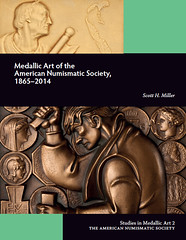 Medallic Art of the American Numismatic Society, 1865-2014
Medallic Art of the American Numismatic Society, 1865-2014
by Scott H. Miller
hardcover, illus.
ISBN-13: 978-0-89722-335-5
List price: $150 (plus S&H)
Member price: $105 (plus S&H)
http://numismatics.org/Store/ANSMedals
NEW BOOK: KUSHAN, KUSHANO-SASANIAN, AND KIDARITE COINS
 Kushan, Kushano-Sasanian, and Kidarite Coins.
Kushan, Kushano-Sasanian, and Kidarite Coins.
by David Jongeward and Joe Cribb with Peter Donovan
2015
List price: US$150
ISBN-13: 978-0-89722-334-8 Hardback, 1 vols, 414pp
http://numismatics.org/Store/Kushans

BANK OF CANADA SOUVENIR BOOKS

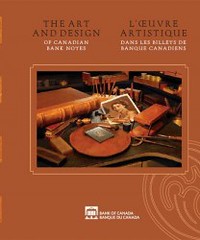
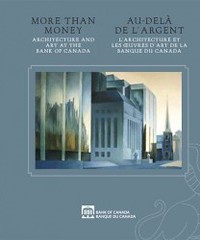
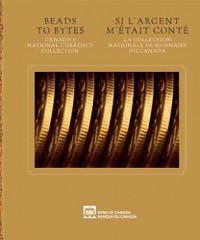
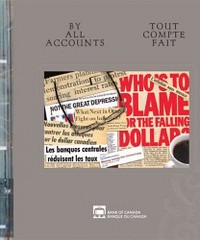 The fifth and final book, “By All Accounts” presents a portrait of the Bank from the perspective of outside observers, showing how Canadians have perceived the performance of their central bank over the decades through the eyes of those who monitor its work on the public's behalf. Soft cover, 128 pages (2010).
The fifth and final book, “By All Accounts” presents a portrait of the Bank from the perspective of outside observers, showing how Canadians have perceived the performance of their central bank over the decades through the eyes of those who monitor its work on the public's behalf. Soft cover, 128 pages (2010).
NEW BOOK: A HISTORY OF THE CANADIAN DOLLAR
(www.coinbooks.org/esylum_v15n40a05.html)
BOOK REVIEW: COINAGE IN THE ROMAN ECONOMY
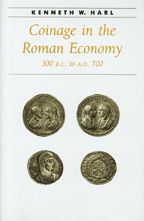 Harl, Kenneth W. Coinage in the Roman Economy: 300 BC to AD 700. Johns Hopkins University Press (1996). 472 pages.
Harl, Kenneth W. Coinage in the Roman Economy: 300 BC to AD 700. Johns Hopkins University Press (1996). 472 pages.
Coinage in the Roman Economy by Kenneth Harl, Ph.D.
(www.coinweek.com/ancient-coins/first-read-coinage-roman-economy/)
Coinage in the Roman Economy, 300 B.C. to A.D. 700
(https://jhupbooks.press.jhu.edu/content/coinage-roman-economy-300-bc-ad-700)
GEORGE CUHAJ JOINS ARCHIVES INTERNATIONAL AUCTIONS

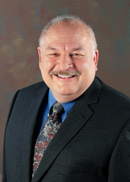 Mr. Cuhaj brings forty years of collecting experience to the firm. For the past twenty years he has been the editor of the Standard Catalog of World Coins and Standard Catalog of World Paper Money series at Krause Publications in Iola, Wisconsin. Prior to that he was with Stack’s Rare Coins and the American Numismatic Society as their first computer systems operator in the early 1980s.
Mr. Cuhaj brings forty years of collecting experience to the firm. For the past twenty years he has been the editor of the Standard Catalog of World Coins and Standard Catalog of World Paper Money series at Krause Publications in Iola, Wisconsin. Prior to that he was with Stack’s Rare Coins and the American Numismatic Society as their first computer systems operator in the early 1980s.
JEREMY CHEEK RETIRES FROM MORTON & EDEN
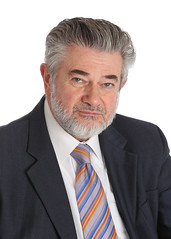 Jeremy Cheek, the Queen’s numismatist, has announced he is to retire from his position as a specialist valuer at London-based international coins and medals auctioneers Morton & Eden.
Jeremy Cheek, the Queen’s numismatist, has announced he is to retire from his position as a specialist valuer at London-based international coins and medals auctioneers Morton & Eden.
THE BOOK BAZARRE
BRUCE BARTELT ON THE MONEY MAKER, BOTTLE TOKENS, ST. ELIGIUS
 I saw your item regarding the “Money Maker” in the last issue and had to reply “I had one of those!” (as was titled a book on baby-boomer toys I saw somewhere). Actually I think it was my older brother who owned the trick counterfeiting tool. The mechanism by which it worked I thought was clever - but like a good magician, I won’t reveal the secret.
I saw your item regarding the “Money Maker” in the last issue and had to reply “I had one of those!” (as was titled a book on baby-boomer toys I saw somewhere). Actually I think it was my older brother who owned the trick counterfeiting tool. The mechanism by which it worked I thought was clever - but like a good magician, I won’t reveal the secret.
HEY KIDS, WANT TO COUNTERFEIT MONEY?
(www.coinbooks.org/esylum_v18n05a30.html)

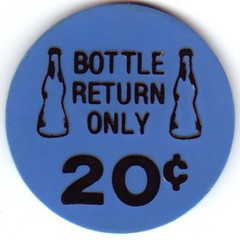
And going way back to the discussion of the St. Eligius medal,
I remembered this from an old Numismatic Scrapbook advertisement, 1966 (attached). I liked the medal, but only eventually purchased one at a small show in Indiana in the early ‘70s (for less than a dollar).
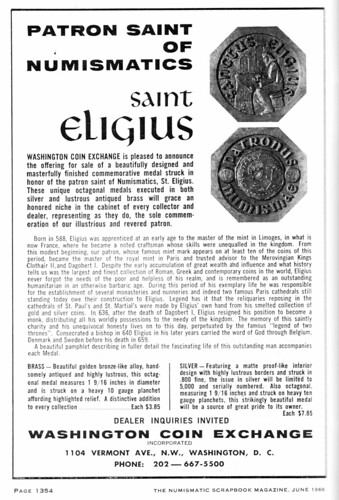
MORE ON THE SAINT ELIGIUS MEDAL
(www.coinbooks.org/esylum_v16n45a21.html)
NOTES FROM E-SYLUM READERS: FEBRUARY 15, 2015

NOTES FROM E-SYLUM READERS: FEBRUARY 8, 2015 : What is the Highest Value Currency Unit?
(www.coinbooks.org/esylum_v18n06a08.html)
BRITAIN'S 1M AND 100M POUND BANKNOTES
(www.coinbooks.org/esylum_v16n04a22.html)
TEXAS MAN PAYS TAXES IN FOLDED DOLLAR BILLS
(www.coinbooks.org/esylum_v18n06a20.html)
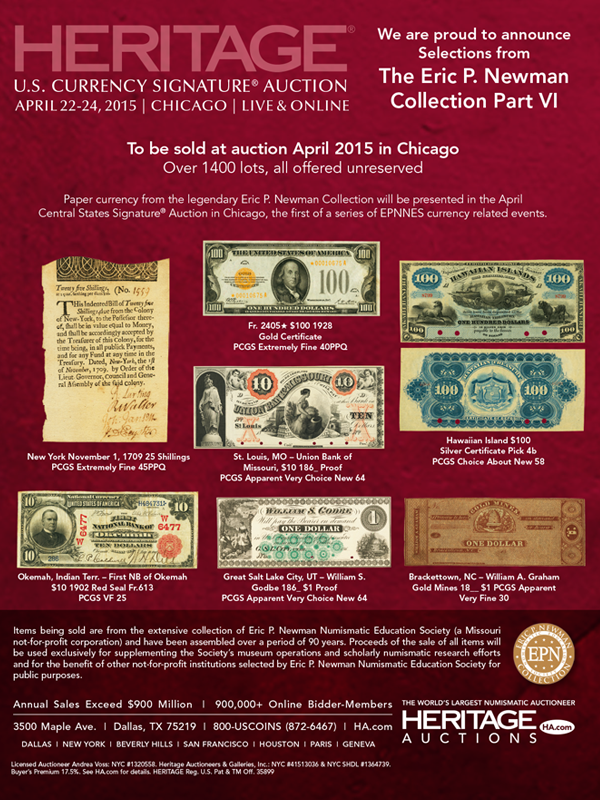
HOMESTEAD NATIONAL MONUMENT QUARTER LAUNCH



WAYNE'S NUMISMATIC DIARY: FEBRUARY 15, 2015
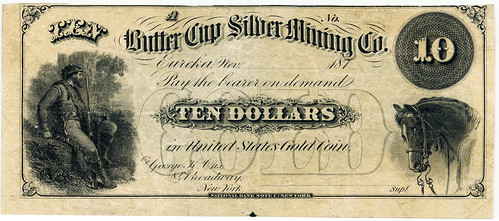

Butter Cup Silver Mining Co.

Coosa Navigation & Coal Mining Co.
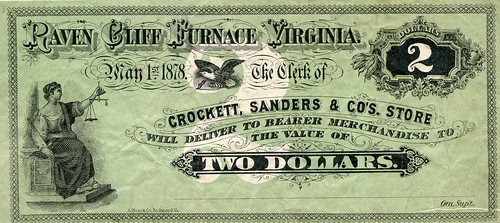
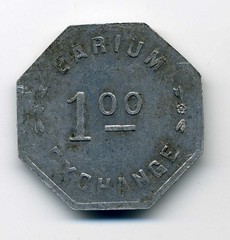

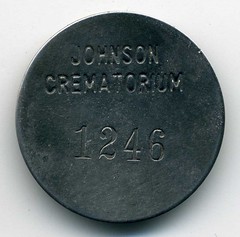 The second item is actually a gift from Dave Schenkman to my wife, Heather: it's a crematorium tag from Johnson Crematorium. It's undated, doesn't specify a town, unholed, and appears it hasn't been in the retort (oven) like many of them are. Heather and I did some researching and we think it's from a now-defunct funeral home in Naples, Florida. Unlike some of the pieces Heather wrote about in her TAMS article, this one may have been placed outside the retort. A neat variety!
The second item is actually a gift from Dave Schenkman to my wife, Heather: it's a crematorium tag from Johnson Crematorium. It's undated, doesn't specify a town, unholed, and appears it hasn't been in the retort (oven) like many of them are. Heather and I did some researching and we think it's from a now-defunct funeral home in Naples, Florida. Unlike some of the pieces Heather wrote about in her TAMS article, this one may have been placed outside the retort. A neat variety!
THE BOOK BAZARRE
ANS PARTNERS WITH HATHITRUST
 In a sweeping effort to make its older and out-of-print publications available to the public as Open Access, the ANS has partnered with HathiTrust, a large, collaborative repository of digital content from research libraries and publishers that includes content digitized by Google Books and Internet Archive. Over 10 million volumes are available to research and read.
In a sweeping effort to make its older and out-of-print publications available to the public as Open Access, the ANS has partnered with HathiTrust, a large, collaborative repository of digital content from research libraries and publishers that includes content digitized by Google Books and Internet Archive. Over 10 million volumes are available to research and read.
www.hathitrust.org
THE PARIS MINT'S WAVY COIN DESIGN
 Convex/concave coins are being issued in increasing abundance since technology developed by the Monnaie de Paris has been adopted and adapted at mints in Australia, Poland and the United States.
Convex/concave coins are being issued in increasing abundance since technology developed by the Monnaie de Paris has been adopted and adapted at mints in Australia, Poland and the United States.
Years before convex/concave coins debuted, 'un ultime franc' coin made waves
(www.coinworld.com/insights/years-before-convex-concave-coins--french-coin-made-waves-.html)
ON THE TYPES OF COIN EDGES


http://www.coincommunity.com/forum/topic.asp?TOPIC_ID=21796

Archives International Auctions, Part XXIII
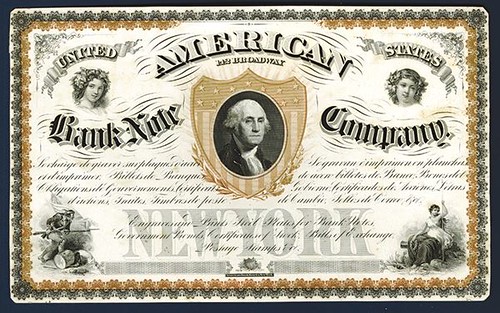
1580 Lemoine Avenue, Suite #7
Fort Lee, NJ 07024
Phone: 201-944-4800
Email:
info@archivesinternational.com
WWW.ARCHIVESINTERNATIONAL.COM
THE ARAGON BALLROOM ENCASED FRANKLIN HALF
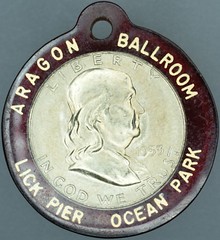 That bakelite encased Franklin Half dollar is from Venice Calif. -
That bakelite encased Franklin Half dollar is from Venice Calif. -
Aragon Ballroom (Ocean Park, Santa Monica, California)
(http://en.wikipedia.org/wiki/Aragon_Ballroom_
(Ocean_Park,_Santa_Monica,_California))
MORE ON ENCASED COINS
(www.coinbooks.org/esylum_v18n06a09.html)
FERROTYPES FROM LINCOLN'S SECOND CAMPAIGN SOUGHT
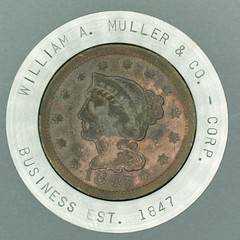 Let me add a comment about the encased coins, especially the encased 1847 cent. I am not going to brag on all the neat pieces I have because I don't collect them, except to buy and sell.
Let me add a comment about the encased coins, especially the encased 1847 cent. I am not going to brag on all the neat pieces I have because I don't collect them, except to buy and sell.
MORE ON ENCASED COINS
(www.coinbooks.org/esylum_v18n06a09.html)

SOME INTERESTING MEDALS: FEBRUARY 15, 2015
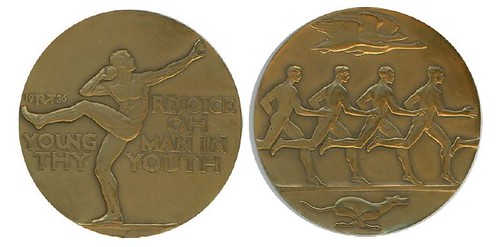
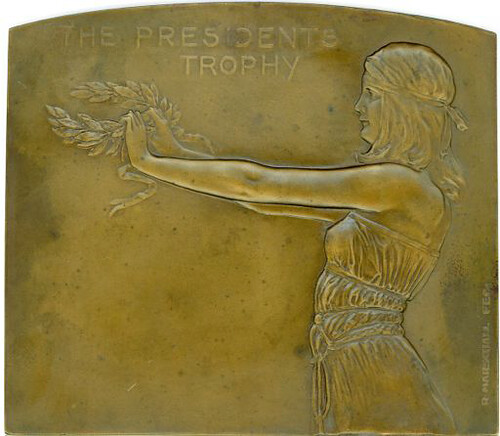


THE O K VENDER GAMBLING MACHINE TOKEN
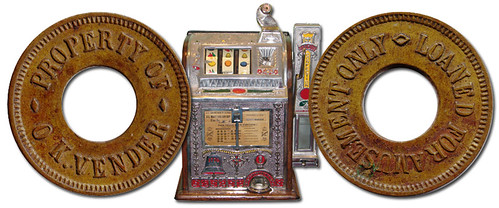
PROPERTY OF O K VENDE
(www.stacksbowers.com/NewsMedia/Blogs/TabId/780/ArtMID
/2678/ArticleID/64973/PROPERTY-OF-O-K-VENDER.aspx)
BANK OF AMERICA $5000 COLOR FACE PROOF
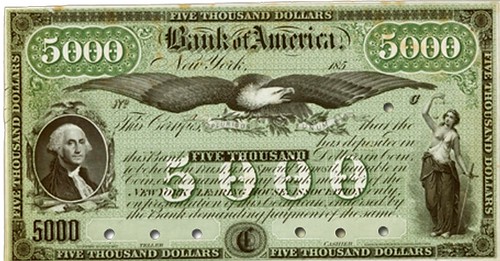
Impressive Bank of America $5000 Color Face Proof
(www.stacksbowers.com/NewsMedia/Blogs/TabId/780/ArtMID/
2678/ArticleID/64979/Impressive-Bank-of-America-5000-Color-Face-Proof.aspx)
THE BOOK BAZARRE
OFFICIALS ACCUSE ARTIST OF PRINTING COUNTERFEIT MONEY
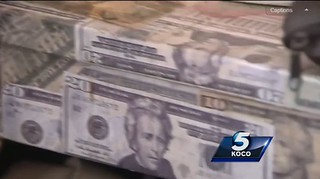 An Oklahoma City man was arrested Tuesday after being accused of printing counterfeit money. But he says it’s all a mistake.
An Oklahoma City man was arrested Tuesday after being accused of printing counterfeit money. But he says it’s all a mistake.
Officials accuse artist of printing counterfeit money
(www.koco.com/crime/Officials-accuse-artist-of-printing-counterfeit-money/31262994)
THE BOOK BAZARRE
LARGE HOARD OF ANGLO SAXON COINS DISCOVERED
 A hoard of Anglo Saxon coins found in a Buckinghamshire village is the largest discovered since the Treasure Act was introduced.
A hoard of Anglo Saxon coins found in a Buckinghamshire village is the largest discovered since the Treasure Act was introduced.
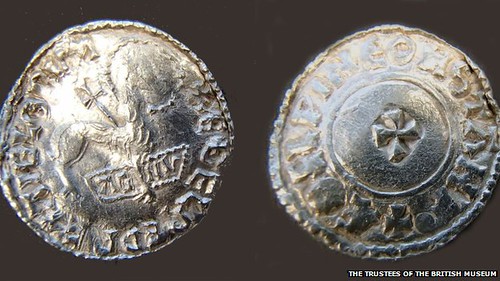
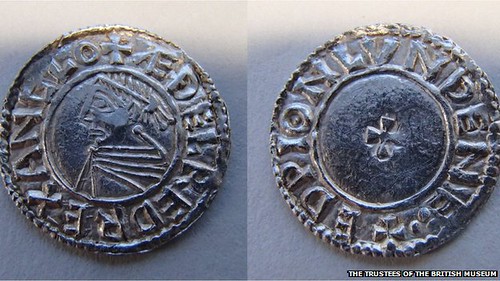
Hoard of Anglo Saxon coins largest discovered under Treasure Act
(www.bbc.com/news/uk-england-beds-bucks-herts-31361054)
 The largest recorded hoard of Anglo-Saxon coins found in Britain might still be hidden in the soil if Paul Coleman had not argued with a fellow metal detectorist about who should get out of the other’s way.
The largest recorded hoard of Anglo-Saxon coins found in Britain might still be hidden in the soil if Paul Coleman had not argued with a fellow metal detectorist about who should get out of the other’s way.
Argument led to greatest find of Anglo-Saxon coins
(www.thetimes.co.uk/tto/news/uk/article4349839.ece)
HUNGARIAN MINT STRIKES WOODEN MEDAL

Hungarian Mint strikes wooden medal on coinage press
(www.coinworld.com/news/hungarian-mint-strikes-wooden-medal-on-coinage-press.html)
DICK JOHNSON AND DONALD TRITT, WOODEN MEDAL EXPERT
(www.coinbooks.org/esylum_v09n38a08.html)
SOME BACKGROUND ON WOODEN MEDALS
(www.coinbooks.org/esylum_v09n39a16.html)
HOW ARE WOODEN MEDALS MADE?
(www.coinbooks.org/esylum_v10n18a26.html)

EROTICISM ON ANCIENT COINS
 In Greek mythology, satyrs were lustful woodland spirits, companions of Dionysus the wine god (so they were often portrayed both drunk and aroused). For over a century (c. 525 – 411 BCE) the Aegean island of Thasos, famed for wine, issued coins depicting a satyr behaving inappropriately with a protesting nymph.
In Greek mythology, satyrs were lustful woodland spirits, companions of Dionysus the wine god (so they were often portrayed both drunk and aroused). For over a century (c. 525 – 411 BCE) the Aegean island of Thasos, famed for wine, issued coins depicting a satyr behaving inappropriately with a protesting nymph.
Aphrodite, daughter of Zeus, was the Greek goddess of love, beauty and sexuality. Her Roman equivalent was Venus. Aphrodite was a popular subject on Greek coins, and even more popular on Roman ones.
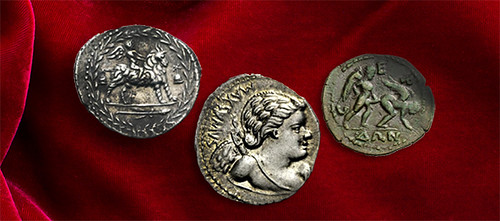
 Two Greek cities on opposite sides of the Hellespont commemorated a legendary love story on their Roman provincial coinage.
Two Greek cities on opposite sides of the Hellespont commemorated a legendary love story on their Roman provincial coinage.
Eroticism on Ancient Coins (Adults Only)
(www.coinweek.com/ancient-coins/eroticism-ancient-coins-adults/)
DENVER MINT WATER MAIN BURST
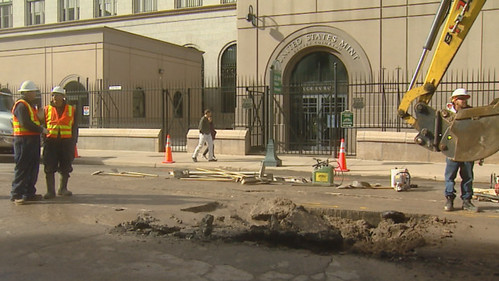
Water Main Break Repairs Continue At U.S. Mint Entrance
(http://denver.cbslocal.com/2015/02/12/water-main-break-repairs-continue-at-u-s-mint-entrance/)

